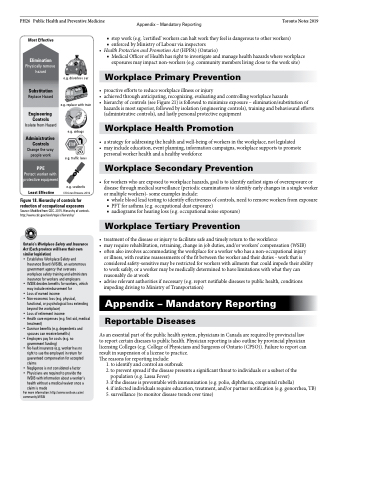Page 1244 - TNFlipTest
P. 1244
PH26 Public Health and Preventive Medicine Appendix – Mandatory Reporting Toronto Notes 2019
Most Effective
■ stop work (e.g. ‘certified’ workers can halt work they feel is dangerous to other workers)
■ enforced by Ministry of Labour via inspectors
• HealthProtectionandPromotionAct(HPPA)(Ontario)
■ Medical Officer of Health has right to investigate and manage health hazards where workplace exposures may impact non-workers (e.g. community members living close to the work site)
Workplace Primary Prevention
• proactiveeffortstoreduceworkplaceillnessorinjury
• achievedthroughanticipating,recognizing,evaluatingandcontrollingworkplacehazards
• hierarchyofcontrols(seeFigure21)isfollowedtominimizeexposure–elimination/substitutionof
hazards is most superior, followed by isolation (engineering controls), training and behavioural efforts (administrative controls), and lastly personal protective equipment
Workplace Health Promotion
• astrategyforaddressingthehealthandwell-beingofworkersintheworkplace,notlegislated
• mayincludeeducation,eventplanning,informationcampaigns,workplacesupportstopromote
personal worker health and a healthy workforce
Workplace Secondary Prevention
• forworkerswhoareexposedtoworkplacehazards,goalistoidentifyearliestsignsofoverexposureor disease through medical surveillance (periodic examinations to identify early changes in a single worker or multiple workers)- some examples include:
■ whole blood lead testing to identify effectiveness of controls, need to remove workers from exposure ■ PFT for asthma (e.g. occupational dust exposure)
■ audiograms for hearing loss (e.g. occupational noise exposure)
Workplace Tertiary Prevention
• treatmentofthediseaseorinjurytofacilitatesafeandtimelyreturntotheworkforce
• mayrequirerehabilitation,retraining,changeinjobduties,and/orworkers’compensation(WSIB)
• oftenalsoinvolvesaccommodatingtheworkplaceforaworkerwhohasanon-occupationalinjury
or illness, with routine reassessments of the fit between the worker and their duties - work that is considered safety-sensitive may be restricted for workers with ailments that could impede their ability to work safely, or a worker may be medically determined to have limitations with what they can reasonably do at work
• adviserelevantauthoritiesifnecessary(e.g.reportnotifiablediseasestopublichealth,conditions impeding driving to Ministry of Transportation)
Appendix – Mandatory Reporting
Reportable Diseases
As an essential part of the public health system, physicians in Canada are required by provincial law to report certain diseases to public health. Physician reporting is also outline by provincial physician licensing Colleges (e.g. College of Physicians and Surgeons of Ontario (CPSO)). Failure to report can result in suspension of a license to practice.
The reasons for reporting include:
1. to identify and control an outbreak
2. to prevent spread if the disease presents a significant threat to individuals or a subset of the
population (e.g. Lassa Fever)
3. if the disease is preventable with immunization (e.g. polio, diphtheria, congenital rubella)
4. if infected individuals require education, treatment, and/or partner notification (e.g. gonorrhea, TB) 5. surveillance (to monitor disease trends over time)
Substitution
Replace Hazard
Engineering Controls Isolate from Hazard
Administrative Controls Change the way people work
PPE
Protect worker with protective equipment
e.g. driverless car
e.g. replace with train
e.g. airbags
STOP
Figure 18. Hierarchy of controls for reduction of occupational exposures
Source: Modified from CDC. 2015. Hierarchy of controls. http://www.cdc.gov/niosh/topics/hierarchy/
Ontario’s Workplace Safety and Insurance Act (Each province will have their own similar legislation)
• Establishes Workplace Safety and
Insurance Board (WSIB), an autonomous government agency that oversees workplace safety training and administers insurance for workers and employers
• WSIB decides benefits for workers, which may include reimbursement for
• Loss of earned income
• Non-economic loss (e.g. physical,
functional, or psychological loss extending
beyond the workplace)
• Loss of retirement income
• Health care expenses (e.g. first-aid, medical
treatment)
• Survivor benefits (e.g. dependents and
spouses can receive benefits)
• Employers pay for costs (e.g. no
government funding)
• No-fault insurance (e.g. worker has no
right to sue the employer) in return for guaranteed compensation for accepted claims
• Negligence is not considered a factor
• Physicians are required to provide the
WSIB with information about a worker’s health without a medical waiver once a claim is made
For more information: http://www.wsib.on.ca/en/ community/WSIB
SPEED LIMIT
Least Effective
e.g. traffic laws
e.g. seatbelts ©Kristen Browne 2016
20
Elimination
Physically remove hazard
PUSH


